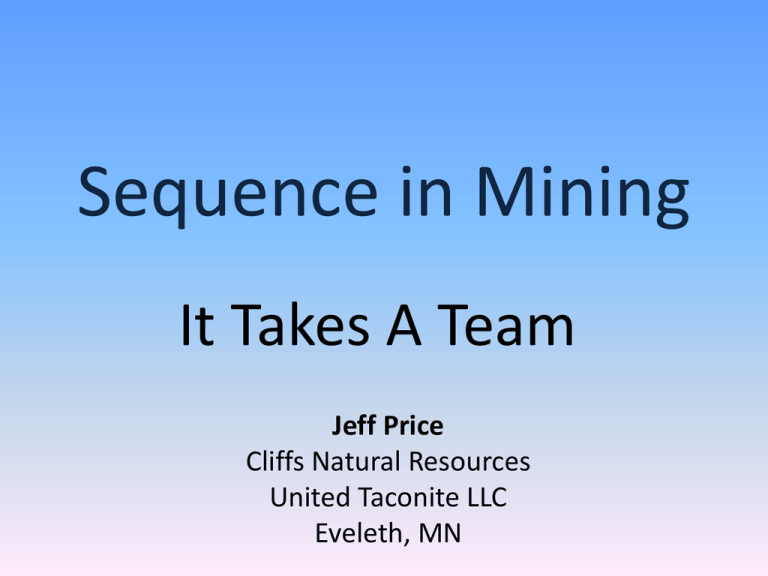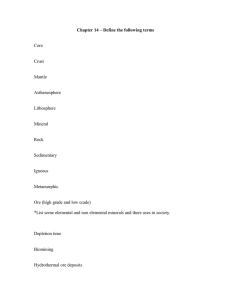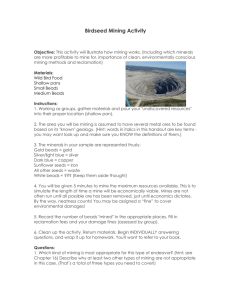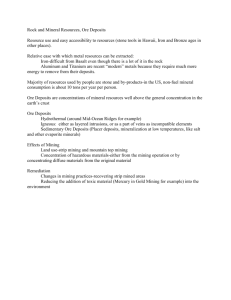Taconite Mining Sequence
advertisement

Sequence in Mining It Takes A Team Jeff Price Cliffs Natural Resources United Taconite LLC Eveleth, MN Objective This activity will exhibit the steps that are taken to find, extract, process and use mineral resources. The students will be able to describe the major steps that a company must follow from initial discovery of a mineral deposit through use of the finished mineral product. The students will also be able to formulate ideas on ways to use waste products generated during mineral processing. Skills utilized in this activity include: mapping, mathematics, economics, decision-making and teamwork. Modified from Women in Mining Activity Mining in a nutshell 50 pieces of the following pony beads: yellow, red, green, white, black Play money ($1,000,000 in various denominations for each group) 8 ½” x 11” graph paper Play sand (5 solo cups worth) Play-doh 5 Tupperware containers Small sieve fabric (coarse screened – purchased at fabric store) Plastic Spoon Clear plastic tube (purchased at uline.com) Materials Preparations 1. Prior to the classroom, prepare each container by placing a layer of play-doh at the bottom of the container. 2. Note: Yellow=Gold, White=Silver, Green=Copper, Red=Iron, and Black=coal. 3. Place beads on the play-doh concentrating most of the pieces in one area, but save a few for the top. 4. Cover with sand having the remaining few beads slightly exposed on top. Strategically place containers around the classroom. Activity Divide the students into groups of 4 to 5. Pick a team name for each group. Each company is given a budget of $1 million to start up a mine. PHASE 1: MAP MAKING At the beginning of class, have each student create a base map of the classroom showing all the major features like doors, windows, tables, chairs, cabinets, etc. Make sure the students indicate north on the map. (Have them draw the map to scale and include a legend to increase the difficulty level.) Keep track of how many minutes used to create the map. (5 minutes maximum) PHASE 2: Exploration WHAT TO LOOK FOR? Valuable Minerals Iron, Gold, Silver, Platinum, Copper, Diamonds, Coal, Oil, Salts, Gypsum, etc. Map out the area Have the team determine what mineral they have discovered on their property. Next phase, find enough resource to establish a mineable ore body… PHASE 3: Drilling Each company must decide where to proceed with exploration drilling based on their preliminary geologic assessment (mapping) Have each company pick a target site and claim it. If two or more companies want the same property, a competitive bid will take place. Use a coin toss or other method to decide who makes the opening bid ($20,000). The winner of the bid will control that property and the loser must find another property. PHASE 3: Drilling Each company can drill up to six holes on their property. Drilling consists of coring with the clear tube to determine if there is enough to represent valuable ore. Calculate the cost of drilling at $30,000 per sample. PHASE 4: Mining Now that each company has mapped and drilled their property, it is time to put the information to the test by mining. Mine the area by digging out the area of the ore body with the spoon and placing the material through the sieve to separate the ore from the waste. Keep track of how many scoops taken (PHASE 5 of worksheet). Once the area is economically mined out (not all the beads may be collected), the mine must be valued. PHASE 5: Reclamation Phase Once the mining is complete and all ore is exhausted, the mine must be reclaimed to eliminate the hole in the ground and bring back the area close to what it looked like prior to mining OR better. Calculate the cost of reclaiming the mine at 10% of the gross profit. (Example $200,000 x 0.10 = $20,000) PHASE 6: Valuing The Mine Multiply the total number of scoops by $10,000. This will represent the cost of mining (movement of ore and waste). Tally the number of beads recovered and multiply by the value given to the color. Gold=$400,000; Silver=$100,000; Copper=$50,000; Iron=$20,000; Coal=$10,000. This is the gross profit. Determine whether each group has a profit or a loss for the activity by subtracting the reclaim cost and cost of mining from the gross profit. The NET PROFIT/LOSS. Recycle Phase Think of ways to recycle the BEADS based on their uses and what they are made from. Ideas such as, melt the BEADS down and make PLASTIC BOTTLES? Look on the internet to get more ideas… More Fun Activities… www.hwscience.com/APES/units/.../Cookie%20Mining%20Lab.pdf www.geosociety.org/educate/LessonPlans/i_rocks.htm www.coaleducation.org/lessons/wim/18.htm www.womeninmining.org/activities/Mining_in_a_Nutshell_Advanced.pdf www.womeninmining.org/activities/Mining_in_a_Nutshell_Lower.pdf www.mii.org/lessons.html







